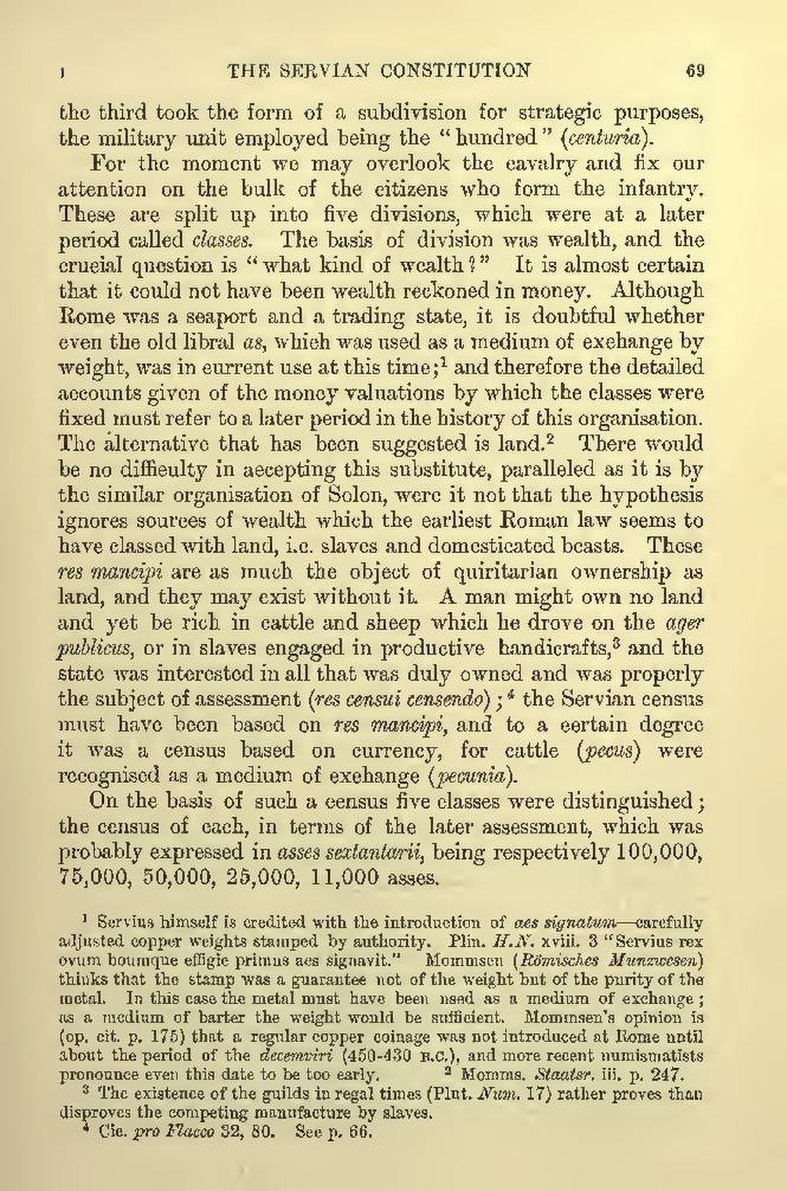the third took the form of a subdivision for strategic purposes, the military unit employed being the "hundred" (centuria).
For the moment we may overlook the cavalry and fix our attention on the bulk of the citizens who form the infantry. These are split up into five divisions, which were at a later period called classes. The basis of division was wealth, and the crucial question is "what kind of wealth?" It is almost certain that it could not have been wealth reckoned in money. Although Rome was a seaport and a trading state, it is doubtful whether even the old libral as, which was used as a medium of exchange by weight, was in current use at this time;[1] and therefore the detailed accounts given of the money valuations by which the classes were fixed must refer to a later period in the history of this organisation. The alternative that has been suggested is land.[2] There would be no difficulty in accepting this substitute, paralleled as it is by the similar organisation of Solon, were it not that the hypothesis ignores sources of wealth which the earliest Roman law seems to have classed with land, i.e. slaves and domesticated beasts. These res mancipi are as much the object of quiritarian ownership as land, and they may exist without it. A man might own no land and yet be rich in cattle and sheep which he drove on the ager publicus, or in slaves engaged in productive handicrafts,[3] and the state was interested in all that was duly owned and was properly the subject of assessment (res censui censendo);[4] the Servian census must have been based on res mancipi, and to a certain degree it was a census based on currency, for cattle (pecus) were recognised as a medium of exchange (pecunia).
On the basis of such a census five classes were distinguished; the census of each, in terms of the later assessment, which was probably expressed in asses sextantarii, being respectively 100,000, 75,000, 50,000, 25,000, 11,000 asses.
- ↑ Servius himself is credited with the introduction of aes signatum—carefully adjusted copper weights stamped by authority. Plin. H.N. xviii. 3 "Servius rex ovum boumque effigie primus aes signavit." Mommsen (Römisches Munzwesen) thinks that the stamp was a guarantee not of the weight but of the purity of the metal. In this case the metal must have been used as a medium of exchange; as a medium of barter the weight would be sufficient. Mommsen's opinion is (op. cit. p. 175) that a regular copper coinage was not introduced at Rome until about the period of the decemviri (450-430 B.C.), and more recent numismatists pronounce even this date to be too early.
- ↑ Momms. Staatsr. iii. p. 247.
- ↑ The existence of the guilds in regal times (Plut. Num. 17) rather proves than disproves the competing manufacture by slaves.
- ↑ Cic. pro Flacco 32, 80. See p. 66.
